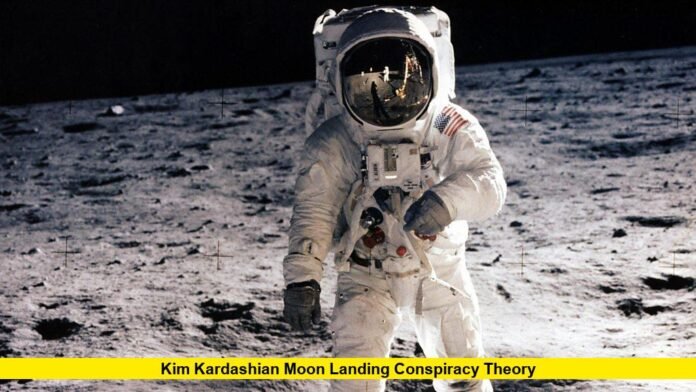The Kim Kardashian Moon Landing Conspiracy Theory has taken over headlines this week after the reality star publicly questioned whether the 1969 Apollo 11 Moon landing ever happened. The remarks quickly sparked widespread debate online, prompting an official response from NASA’s top leadership.
Kim Kardashian’s Controversial Claim
During the latest episode of The Kardashians, aired on October 30, 2025, Kim Kardashian told co-star Sarah Paulson that she believed the first Moon landing might have been faked. She said she had seen interviews suggesting Buzz Aldrin, one of the Apollo 11 astronauts, hinted that the event was staged for television.
Kardashian remarked, “There was no scary moment—because it didn’t happen.” Later in a confessional clip, she doubled down, saying, “I love a good conspiracy, but honestly, I don’t think we went to the Moon.”
Her comments referenced some of the most common claims made by Moon landing skeptics, including:
- The American flag appeared to “wave” despite the Moon’s lack of atmosphere.
- No stars are visible in lunar surface photos.
- The lighting and shadows in footage appear inconsistent with natural sunlight.
These remarks quickly went viral, with clips circulating across TikTok, Instagram, and X (formerly Twitter). The phrase “Kim Kardashian Moon Landing” trended globally within hours.
NASA Fires Back
NASA Administrator Sean Duffy swiftly responded to Kardashian’s comments on X, writing, “Yes, @KimKardashian, we’ve been to the Moon—six times!” He added that the Apollo missions remain among humanity’s greatest scientific accomplishments and that every aspect of them is thoroughly documented and verified.
He also noted that NASA’s upcoming Artemis missions will return humans to the Moon within this decade—proof, he said, that “we’ve done it before and we’ll do it again.”
NASA released a short statement reaffirming:
- Six crewed lunar missions took place between 1969 and 1972.
- Over 800 pounds of lunar rock samples are stored and studied on Earth.
- Independent international tracking confirmed each mission’s trajectory.
The agency reiterated that conspiracy theories often misrepresent photographic or physical evidence without understanding the science behind them.
Buzz Aldrin’s Name Resurfaces
One point that fueled Kardashian’s claim involved an old video clip of astronaut Buzz Aldrin. Some online users interpreted his comments as admitting the Moon landing was faked. NASA clarified that the clip was heavily edited and taken out of context—Aldrin was referring to a television animation used during the 1969 broadcast, not the actual lunar event.
Aldrin, now 95, has repeatedly stated that he personally walked on the Moon. His verified social media accounts have long shared photos, mission logs, and reflections from Apollo 11 to counter misinformation.
The Power of Celebrity Influence
Kardashian’s platform amplifies the reach of her statements. With hundreds of millions of followers across social media, her comments triggered millions of engagements, reigniting an old debate long dismissed by scientists.
Experts in media studies noted that when celebrities discuss conspiracy theories—even casually—it can blur the line between entertainment and misinformation. Within hours of the episode airing, several science educators and fact-checking accounts stepped in to debunk the claims, using NASA archives and modern satellite imagery of Apollo landing sites as evidence.
The debate also underscores how easily misinformation spreads in the digital age, where short video edits or speculative discussions can overshadow decades of scientific proof.
NASA’s Educational Opportunity
Rather than ignoring the controversy, NASA used the moment to spark public interest in space history. The agency posted verified Apollo mission footage, images of lunar artifacts, and explanations addressing the most common Moon-landing myths, including:
- Why the flag moved: It was caused by inertia from being planted, not wind.
- No visible stars: Camera exposure settings favored bright lunar surfaces, not dim stars.
- Strange shadows: Light behaves differently on the Moon’s reflective terrain.
NASA also invited Kim Kardashian to visit the Kennedy Space Center to learn about the upcoming Artemis missions—intended to return astronauts to the lunar surface by the late 2020s. The offer was viewed as a lighthearted but educational response, turning a viral moment into a teachable opportunity.
Public Reactions and Online Divide
Public reactions have been split. Some viewers applauded Kardashian for “asking questions,” while others criticized her for spreading misinformation to such a massive audience. Many users commented that while conspiracy discussions can be entertaining, spreading false claims about verified historical events undermines science education.
Astrophysicists, space enthusiasts, and historians weighed in online, sharing compelling photos of the Apollo landing sites captured by modern lunar orbiters—showing equipment left behind by astronauts, including descent stages and rover tracks.
Others suggested Kardashian’s remarks highlight the need for better science communication in popular culture, especially for younger audiences who consume most of their information through social media platforms.
Why This Story Matters
The Kim Kardashian Moon Landing Conspiracy Theory might seem like just another viral entertainment headline, but it touches on a much larger issue: the challenge of balancing celebrity influence with factual accuracy in the age of social media.
It also reflects the power of digital platforms to reshape public conversations overnight. NASA’s swift response demonstrated a growing awareness among institutions that misinformation must be addressed immediately—and directly—to prevent confusion from spreading.
Looking Ahead
As the Artemis program prepares to send the next generation of astronauts—this time including women and people of color—to the Moon, NASA hopes public engagement will shift back toward curiosity and pride, rather than doubt.
For Kim Kardashian, the controversy may serve as a reminder of how even a single comment can ignite global discussions. Whether or not she accepts NASA’s invitation, her remarks have reignited interest in space exploration for millions—perhaps unintentionally turning skepticism into curiosity.
The conversation about the Moon landing shows no signs of slowing down—but one thing is certain: NASA isn’t backing down from the truth.
What do you think—should NASA continue engaging directly with celebrity claims, or simply let the evidence speak for itself? Share your thoughts below!
